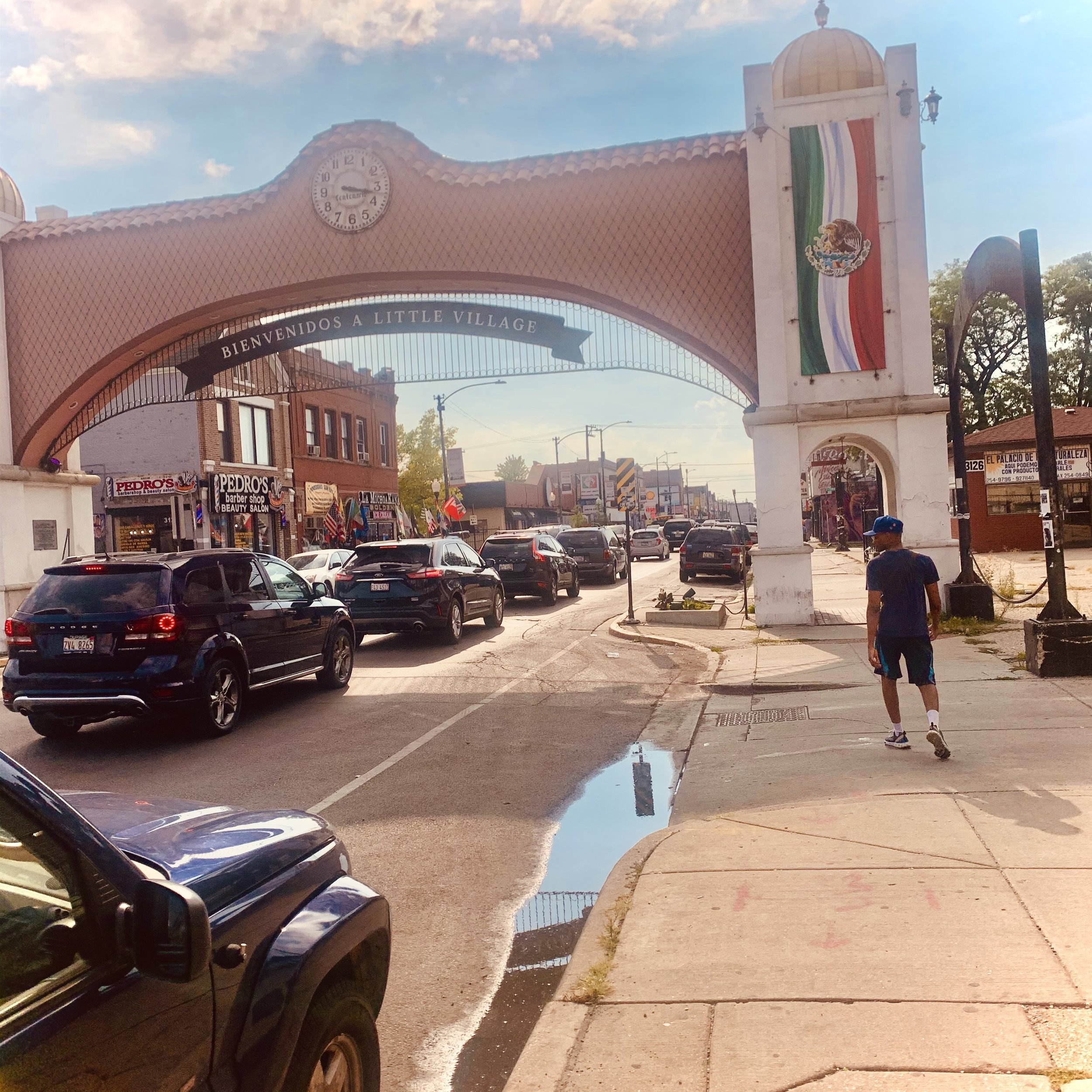OP-ED: I find it ironic that I feel targeted in a place whose history is one of displacement.
The famous “Bienvenidos” arch in Little Village. Photo by Marlena Wadley
 |
By Marlena Wadley, Reporter, The Real Chi |
|---|---|
I kinda love my block, but sometimes it feels like a sundown town.
I moved to Little Village on a whim because my last apartment was sold to new owners. Planted in the middle of the city, I’ve come to love that I can almost travel anywhere easily. When it’s nice out, I like to window shop at Campo Santo, a flower shop right down the street from my house garnished with a huge “coffee” sign. My favorite sound is the rooster two doors down that cock-a-doodle’s its voice on my deck when I tan in the summer.
I want to fully love my neighborhood, but my friends constantly recount stories of being profiled as gangbangers. I usually receive a scowl after nodding hello to the people on my block. And let’s not forget countless eyerolls when I hear the n-word walking down the street from people who don’t look like me.
I find it ironic that I feel targeted in a place whose history is one of displacement. However, I’m sure with Little Village’s history and Chicago’s notorious segregation, I am probably perceived as an outsider.
The Origins of Little Village
Before Little Village was an established neighborhood, it was once used by indigenous peoples to connect across the Mississippi River and the Great Lakes. Of course, by 1833, the United States coercive and manipulative ways displaced the people of the land.
By 1869, it was annexed as Lawndale from Cicero township. In 1871, two business owners sacrificed their business to build an affluent neighborhood for the Anglo-Saxon.
By the 20th century, Lawndale was made up of Czech, Bohemian, and Eastern European immigrants. Then during the 50s and 60s, African Americans began to move into North Lawndale, and that rattled the neighborhood. Wanting to distinguish themselves from the growing African American community in North Lawndale, the Eastern Europeans renamed the “South Lawndale” area “Little Village.”
Here comes the ‘70s and White flight plagued Little Village’s existence. Latinx people were being pushed out of Pilsen due to the development of UIC and as a result, they moved to Little Village. Due to the Latino population increasing, the Eastern European population moved to Berwyn and Cicero, landing them better housing and more employment opportunities.
By the 1980s, Latinos made up 47 percent of the population. And in 1991, the famous landmark arch “Bienvenidos a Little Village” was installed. Now Little Village is 84 percent Latino.
Campo Santo, where I like to window shop featuring the huge “coffee” sign. Photo by Marlena Wadley
It’s beautiful that there is a community of Mexican Americans and immigrants that made a home for themselves after being displaced from another. However, I can’t ignore the way I’m made to feel when existing in these communities.
My intentions are not to diminish the communal enclaves they have built for themselves. I simply want to highlight the intra-segregation that takes place within the neighborhoods of our already highly segregated city.
I recount the fear of all my male friends and the unfriendliness that slaps me in the face when trying to greet my neighbors. I feel like an outsider in my own neighborhood. But why should I feel like that in a place I call home?
I blame de jure and de facto segregation.
Chicago is one of the most segregated cities in this country and it was purposefully set up this way. This painful notion has trickled down to our neighborhoods and into our behavior.
During the riots triggered by George Floyd’s murder, Latino gangs began attacking black residents in the community in defense of the looting taking place all over the city. Initially Latino gangs were trying to protect the neighborhood’s business. However, according to Ald. Michael Rodriguez (22nd) “as the night went on, a few Latino men became “antagonistic” and were indiscriminately targeting Black people driving through the neighborhood”.
I can recount multiple people on my social media page warning black residents to be cautious. Latinx residents strapped with guns paraded my Twitter feed. Latinix mutual warned black people of potential dangerous streets and I couldn’t believe what was happening. Multiple videos circulated around twitter of this antagonistic behavior, as well as witnesses sharing their traumatic experiences via twitter.
I find it ironic that a community whose history reeks of displacement would violently project those same behaviors onto another.
I find it ironic that a community whose history reeks of displacement would violently project those same behaviors onto another.
However, I can’t write this article and not acknowledge the efforts made to counter those behaviors. After the commotion and tension, people took to the streets to denounce the following events. Anti-racist and peace walks were held in Little Village and Pilsen to show solidarity for the black community. The next day another Unity March took place led by grassroots organization El Toro del Pueblo. Those discriminatory notions shouldn’t be indicative about the entire neighborhood of Little Village. However, we can’t ignore the trauma and pain that lingers once smacked with racist and discriminatory rhetoric.
I also think about my own community and how we view other people of color. I cringe at family’s and friends’ racist jokes about Latinix people. I shudder at their scapegoat: Latinx people don’t like Black people. Where did this tension begin? Most importantly, when and where does it end?
I am not writing to point fingers or cast blame on any person of color. I simply want to highlight the issues that exist within our groups in order for us to heal these tensions. White supremacy affects us all so it helps for us all to work towards a united front.


